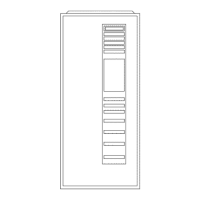--9 UNIT DAMAGE HAZARD
This gas furnace may be used %r construction heat provided
that:
-The t_urnace is permanently installed with all electrical
wiring, piping, air filters, venting and ducting installed
according to these installation instructions. A return air duct
is provided, sealed to the t'ttmace casing, and temainated
outside the space containing the furnace. This prevents a
negative pressure condition as created by the circulating air
blower, causing a flame rollout and/or &awing combustion
products into the strtlctme.
-The t'umace is controlled by a thermostat. It may not be "hot
wired" to provide heat continuously to the stla/cture without
thermostatic control.
-Clean omside air is provided for combustion. This is to
minimize the con'osive effects of adhesives, sealers and other
constr_ction materials. It also prevents the entrainment of
d_wall dust into combustion air, which can cause fouling and
plugging of %mace components.
-The temperature of the return air to the Nmace is maintained
between 55C_F (13%?) and 80°F (27%), with no evening
setback or shutdown. The use of the Nmace while the
structure is under construction is deemed to be intem?ittent
operation per our installation instructions.
-The air temperature rise is within the rated rise range on the
fm'nace rating plate, and the firing rate has been set to the
nameplate value.
-The filters used to clean the circulating air during the
constr_/ction process must be either changed or thoroughly
cleaned prior to occupancy.
-The Nmace, ductwork and filters are cleaned as necessary to
remove &ywall dust and construction debris t)om all HVAC
system components after construction is completed.
-After construction is complete, verify Nmace operating
conditions including ignition, input rate, temperature rise and
venting, according to the manuffcmrer's instluctions.
--9
BACK
A93043
Fig. 14--ProNbit InstNtation on Back
Step 3--Hazardous Locations
FIRE, EXPLOSION, IN J[ R¥ OR DEATH HAZARD
Improper location or inadequate protection could result in fire
or explosion
When the ftlrnace is installed in a residential garage_ fl-_e
burners and ignition sources must be located at least 18 in.
above the floor. The filrnace must be located or protected to
avoid physical damage by vehicles. When the l_lmace is
installed in a public garage, airplane hangar, or other building
having a hazardous atmospherQ the filmace must be installed
in accordance with the NFG( or NS(NGPIC, (See Fig. 160
INSTALLATION
Step l--Leveling Legs (If Desired)
When f_lrnace is used in upflow position with side inlet(s), leveling
legs may be desired. (See Fig. 17.) Install field-supplied,
cotTosion-resistant 5/16°in machine bolts and nuts.
NOTE: The maximum length of bolt should not exceed 1-1/2 in.
FIRE, INJURY OR DEATH HAZARD
Failure to £_llow this warning could result in fire, property
damage, personal injury, or death
Do not install fitrnace on its back. Sa[kty control operation
will be adversely affected. Never connect retura=air ducts to
back of fi/rnace. (See Fig 14.)
Step 2--Furnace Location Re[ative to Cooling
Equipment
71-1ecooling coil must be installed parallel with or on downstream
side of furnace to avoid condensation in heat exchanger. When
installed parallel with a furnace, dampers or other means used to
control flow of air shall be adequate to prevent chilled air fi'om
entering fm_aace. If dampers are manually operated, they must be
equipped with a means to prevent operation of either unit unless
damper is in _hll-heat or full=cool position.
32°F MINIMUM INSTALLED
ASi2R BLENT OR FREEZE
OTECTION REQUIRED
A93058
Fig. 18--Freeze Protection
._' _ 0 !
UNIT DAMAGE HAZARD
Failm'e to fbllow this caution may result in minor property or
unit damage.
If these fi/maces are installed in an unconditioned space
where ambient temperatures may be 32_>F or lower, _?eeze
protection measures must be taken. (See Fig. 15.)
14

